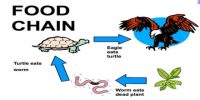Pond Ecosystems are the balance of fish, bacterias, and plants which together support each other. The mutual relation between the living organisms and non- living things of a particular area is known as the ecosystem. In every ecosystem, every organism has a definite habitat and a definite life pattern. It is the main characteristic of an ecosystem.
Pond Ecosystem works on ponds that are shallow enough for the sunlight to pass through it. A pond is a self-sufficient and an ideal example of the ecosystem. In a pond, the intimate relation between the inhabiting living and non-living components is well understood. The non-living objects are various types of organic and inorganic substances such as water, sun rays, CO2, oxygen, calcium, phosphorus, humic acid, etc. The living components are producers, primary consumers, secondary consumers, tertiary consumers, and various types of decomposers.
 Pond Ecosystem
Pond Ecosystem
Producers: Various types of photosynthetic algae and shallow water plants living in the pond are the producers. The floating organisms are called plankton. The minute plants of plankton type are known as phytoplankton. Green aquatic algae and other aquatic plants can live by producing food by the process of photosynthesis, so they are called producers.
Primary consumers: These are various types of floating minute insects, larvae of mosquito, and other microscopic animals like zooplankton, etc. Floating minute animals are called zooplankton. These consumers cannot manufacture their own food and they live on by eating the producers directly.
Secondary consumers: Small fishes, some aquatic insects, prawns, frogs, etc. are secondary consumers. They can neither manufacture their own food nor accept the producers as food. They live on by eating the primary consumers.
Tertiary consumers: Small fishes, prawns, and all other animals that feed, upon the secondary consumers are known as tertiary consumers. Large fishes like shoal, boal, vetki, stork, and heron are the tertiary or highest consumers.
Decomposer: In pond water, various types of fungi and bacteria live as, saprophytes which are- known as a decomposer. These decomposers can live by floating on water or live at the bottom clay. They attack living or dead consumers and help to rot. As a result, organic and inorganic chemical substances usable by the producers have formed again. The producer community of the pond uses these decomposed elements. The flowchart gives an idea about the components of the pond ecosystem.
The freshwater pond ecosystem consists of the following:
- Pond bottom – there is very little oxygen or light at the bottom of the pond. Decomposers and scavengers live here where they feed on dead material.
- Midwater – fish are the main predators here. Food is found on the pond bottom or the pond surface. Animals here breathe through their skin or gills, eg stickleback fish, water fleas, and dragonfly nymphs.
- Pond surface – animals here breathe through their gills, skin, or lungs. There is plenty of oxygen and light here. Animals found here include ducks, water boatmen, midge larvae, and tadpoles.
- Pond margin – plants provide a sheltered habitat for insects and smalls animals such as frogs. There is lots of light and oxygen so plants such as marsh marigold thrive.
- Above the pond surface – birds such as kingfishers and insects like dragonflies are common here.
Pond Ecosystem has a great significance. They provide inhabitation to scarce species and support biodiversity much more than any other freshwater habitat. The ponds provide inhabitation to wetland plants and animals. Pond works with a combination of three food webs at a time. They are not just important for quenching thirst or providing inhabitation but also to add beauty to the mother nature. It touches our heart and we feel calm and close to nature.











